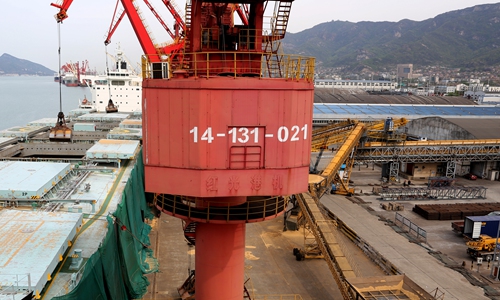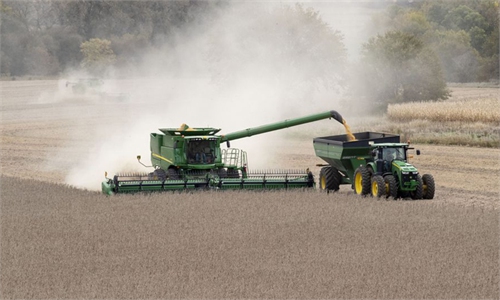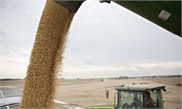
A ship unloads soybeans from Brazil at a terminal in Lianyungang port, East China's Jiangsu Province. The 80,000 tons of soybeans left Brazil in March, and they will mainly be used to make edible oil and soybean meal feed. Photo: cnsphoto
China's agriculture authority on Tuesday unveiled plans to boost the nation's soybean planting sector, including the establishment of a seed production base in Northeast China's Heilongjiang Province.
The move aims to increase the domestic soybean crop's quality and branding, and it will boost the sector's development, but it is unlikely to change China's soybean import structure, experts said.
In a statement, China's Ministry of Agriculture and Rural Affairs said on Tuesday that it has been working to improve domestic soybeans' quality and output, and "is mulling to set up a national high-quality soybean seed base in Heilongjiang."
"There's not enough suitable land in China to grow soybeans, and the new base may find a way to improve yields," Li Guoxiang, a research fellow in the agricultural sector at the Chinese Academy of Social Sciences, told the Global Times on Tuesday.
US soybeans account for a large portion of China's import volume. As bilateral ties between China and the US have witnessed a sharp deterioration, any move by China on soybeans will attract media speculation.
But beyond improving domestic soybeans' quality, the move is unlikely to change China's soybean import structure in the near future, Jiao Shanwei, an agricultural expert, told the Global Times.
According to Jiao, China's annual soybean consumption in recent years has been about 110 million tons. Although the domestic harvest has increased in recent years, reliance on imports is relatively high in light of the domestic supply and demand pattern.
Domestic soybeans are mainly non-GMO as China has banned genetically modified soybeans from entering the food chain. The domestically grown crops are mainly used for food such as tofu and imported soybeans are used mostly to make cooking oil, according to Li.
According to China's official data, about 90 million tons of soybeans are imported annually, accounting for more than 85 percent of China's soybean consumption.
"Imports may decline gradually in the future, but the process and extent of the decline will be relatively small and slow," said Jiao.
Although imported soybeans will still take up a major proportion of total consumption in China for a while, Li said that the nation's new program will help improve the soybean industry structure so as to reduce supply chain risks.
Imports are unlikely to either rise or fall, Jiao said, and "domestic demand for soybean oil has almost reached its limit. The market is basically saturated."



